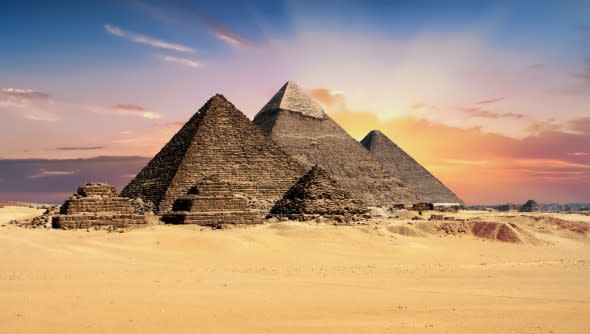Equinox may hold the secret to the mysterious alignment of Egyptian pyramids
The towering pyramids of the Giza Plateau have long stirred a sense of mystery and awe in onlookers due to their remarkable architectural design and feats in engineering. Scholars have speculated for ages on the methods of their construction and near perfect alignment to cardinal points.
Today, an engineer who studies ancient Egyptian architecture has uncovered a technique that may explain the precision of the Great Pyramid's ancient alignment to the North, East, South and West. The proposed technique correlates directly to the rotation of the Earth, and its position to the sun.
By using shadows from the sun during the equinox, Egyptian builders could have used a simple method for calculating these precise directional points, according to a paper recently published in the Journal of Ancient Egyptian Architecture.

Twice a year, the Earth reaches a point during its orbit around the sun when the Northern and Southern hemispheres receive roughly the same amount of daylight, once in the spring and once in the fall.
"The builders of the Great Pyramid of Khufu aligned the great monument to the cardinal points with an accuracy of better than four minutes of arc, or one-fifteenth of one degree," lead author and engineer Glen Dash stated.
According to Dash, the Great Pyramid's neighbors, the Pyramid of Khafre, and Snefru's Red Pyramid, all follow the same alignment angle with the same manner of error, being rotated slightly counterclockwise from the cardinal points.
The exact methods of how ancient Egyptians managed to achieve this level of accuracy is still unknown, but Dash has proposed the use of a gnomon, the part of the sun dial that casts a shadow, and its position during the equinox.
"This is the ʽequinoctial solar gnomon method.' It uses a vertical rod to track the movement of the sun on the equinox," Dash stated.
Dash's method is a variation of another proposal for pyramidal alignment originally presented by researcher Martin Isler.
Under Isler's original technique, "the solar gnomon method," a surveyor starts by placing a rod, or gnomon, in the ground. As the sun rises and sets, the surveyor will watch where the shadow is being cast and mark intervals at its tip.
Over the day, the marks in the ground made by the surveyor will create a smooth curve around the gnomon. The curve, or shadow line, will bend around the rod in the summer, and away from it in the winter.
"At the end of the day, the shadow line being complete, the surveyor takes a string, places it over the gnomon and rotates the taught string around the gnomon, describing a circle which intercepts the shadow line at two points," Dash reported.
These points will lie on an east-west line. Dash's proposed "equinoctial solar gnomon method" is precisely the same process as the above-mentioned method, but it is done specifically on the day of the equinox.
By surveying on the equinox, the process will create a more precise shadow line, the tip of which runs in a straight line, and near perfectly east-west. This eliminates the need for the second step of creating the circle around the rod to find the directional line.
In order to put his method to the test, Dash created a gnomon set up at his Connecticut home on Sept. 22, 2016, the day of the autumnal equinox.
Dash said his revised solar gnomon method is workable and will join many other proposed methods including Isler's.
"As to the methods they actually did use, the Egyptians, unfortunately, left us few clues," Dash wrote in his article. "No engineering documents or architectural plans have been found that give technical explanations demonstrating how the ancient Egyptians aligned any of their temples or pyramids."
While the secrets to how the pyramid builders achieved such perfect alignment may never be known, Dash determined his method is simple and effective.
"It is hard to imagine a method that could be simpler either conceptually or in practice," he stated.
